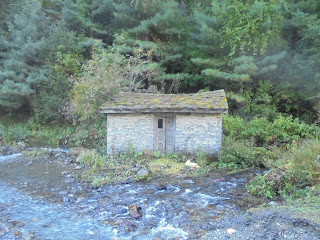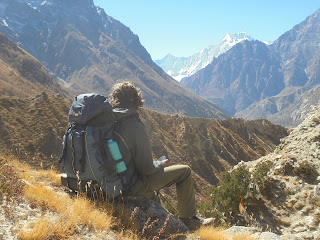Sunday, October 25, 2015
Day 25 - Khatmandu to Australia - homeward bound
Day 24 - Khatmandu - treading water
Day 22 - Khatmandu - same, same
Saturday, October 24, 2015
Day 21 - Khatmandu - recharge
Day 20 - Besishar to Khatmandu - a bus ride to town
We assumed that it would be easy to get transport back to Khatmandu. How wrong we were. After breakfast we went out onto the main street of Besishar, only to find most of the town closed and the street virtually empty. The great festival continued! We walked up to the end of the street, about a kilometer away, this is where the cars, jeeps and microbuses drop off and pick up people who are Trekking. Normally, this place would be buzzing with life, but when you combine the festival, the fuel blockade and the very low trekker numbers, there was absolutely nothing going on. After some asking around, a car was found, but the driver wanted 20,000npr for the trip (about AU$265), even with some bargaining we could not get them below 18,000npr, way too much. Word came through that a tourist bus (a fancy way to describe a bus where you got an actual seat and no one sat on the roof) might be heading to Khatmandu in a few hours.
Lille and I used the time to go and get a shave, quite a bit of fun with a cut throat razor, the barber was disappointed I didn't want a hair cut. We then pretended to be walking out of town, so the bus tour did not think we were too desperate. Eventually, the buss pulled up beside us and offered us a ride for 1,000npr each, a good price under the circumstances. We got good seats up the front, the bus started empty, but over the hours it filled up, some people getting on and off at various stops. It was mostly a lot of fun, we all laughed at the Bollywood movies and music video, questions were asked of us and people were genuinely friendly, we were the only Westerners on the bus and were a bit of a novelty!
Every town we passed through was in festival mode, the roads were empty of traffic, most shops were shut, but there were people everywhere, all dressed up and decorated. Giant swings were set up along the roadside and kids were being swung to enormous heights.
After many hours of travel, we hit the outskirts of Khatmandu, slowly dropping off passengers along the way. The conductor signaled us when we got to the stop nearest to Thamel. We were going to walk, but were too tired, so a 500npr taxi fare put us back in the heart of Thamel, it felt like home! We were very hungry and tired, so it was straight to an old favourite, New Orleans Cafe, where we were welcomed like old friends. Cold Gorkha beer, good food, fast WiFi and cool music..
Then it was back to our old hotel, just OK (the room stunk of sewerage), we owed them a night because they had stored our bags. Tomorrow, we'd find something a little better.
Thamel is a unique place, it's full of Westerners (nothing unusual in that), there are American and German travel groups wandering wide eyed, countless indie travellers strolling in couples or in small groups, looking like they have just finished collage and their on their grand adventure, there are older couples, long experienced in world travel, in Nepal for the countless time, business people and aid workers from across the globe, that almost feel at home, but never quite, and then there are the men of purpose, usually French, Dutch or German, groups of them, relaxed, fit almost always older, men who are here to climb mountains, traverse snow plateaus and places that few of us will ever lay eyes on.
The thing about Thamel that makes it unique in the world is that all journeys in Nepal start and end here. When you arrive in Khatmandu, this is where you come, you eat here, drink the coffee, sit with others and drink beer, buy your trekking goods, your trinkets and presents for home, you sleep here, make friends here, leave for your trek from here....and eventually when your adventure is done, you'll return here. Tired, homesick, hungry for familiar food, a hot shower, music and just a bit of comfort. You'll sit in a cafe and watch the new arrivals with a sense of satisfaction, knowingly smile at them and think "I know, I've seen, I've got the blisters and sunburn to prove it".
The fun thing about Thamel, and a little unexpected, is that just about everyone you met while trekking, will return to Thamel and you'll bump into them, sometimes in a cafe, sometimes on a street corner, sometimes while waiting in a line. And then you'll catch up and talk about your trek and experiences as if your long lost friends, there is a strange shared bond between people who meet on the road.
That night, we went to a pizza restaurant and sat at a random table, only to find that the people on the table next to us were an American couple we met in Bagarchhap. The first of many surprise meetings.
Ah.....Thamel, it's like nowhere else.
Day 19 - Tal to Besishar - oh what a day!
The day started out well, we decided that as we would get a jeep from Chamje orJagat, we did not need to start at the crack of dawn. Once you leave Tal, it's pretty well all down hill. The long climb to Tal on the way up, becomes a steep decent. This is not as easy as it sounds, and is hard work on the knees and feet, all three of us suffering a bit. We some Aussies who were on their way up, turned out they were from Melbourne. It's funny, but all the Aussies we met on the trek (not that many really) were from Victoria, maybe we are the most adventurous.
By lunch time we'd reached Chamje, it's a cute village that looks a little like a wild west town, two - three story buildings with verandas and balconies. We hung for lunch, and then started looking for a jeep. It's funny. Because all day, we'd seen jeeps going down the circuit, but now there was nothing!
Eventually a fully loaded jeep came along, it turned out to be the same guy that had taken us up the mountain. There was no room in the jeep, but he offered us a ride in the back with two local guys and a stack of cargo. Desperate, we took the ride, Jules and I squeezed together and Lille hanging off the tailgate ( a better spot than ours!). It's only 35 km to Besishar, but the track is soooooo bad that it takes about 3 hours. It was a hell of a ride, dust poured into the back, and we felt every bump, constantly banging our heads on the frame, our bodies permanently tense as we tried to brace ourselves. After an hour, we'd only reached Syange, maybe 10km closer to our destination.
The three of us decided we'd had enough and opted to wait for another jeep, it was only 1pm, so I was sure another jeep would come soon..... Nothing, absolutely nothing came by, jeeps were going up, but not going down. Then two jeeps pulled up, it was the mountaineering team we'd met in Chyako, they turned out to be Dutch, not Germans. Unfortunately, they were overloaded and could not help. And so we continued to wait. Just as dark was closing in and the thought of a night in Syange wasd becoming a reality, two empty jeeps rolled in, on their way home to Besishar. They agreed to give us a lift for 1500 npr each (about AU$20). We had the jeep to ourselves, so it was as comfortable as you could get. We still had to hold on for dear life as we rocked and bumped our way along the track, fording countless streams. With only 25 km to go it should have been a breeze, but it took about three hours, the longest three hours you could imagine.
We staggered into Besishar about 8:30, the place shut up tight, except for the drunken guys wandering around enjoying the start of festival, it seemed every day was now the start of festival!we fell into our room at the same hotel as before, exhausted and pretty much done. I'll never forget that strange, surreal jeep journey through the darkness of the mountains.





































































